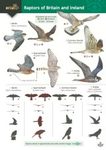![The Barn Owl The Barn Owl]()
Click to have a closer look
About this book
Contents
Biography
Related titles
Recommended titles
About this book
With its heart-shaped face, buff back and wings and pure white underparts, the Barn Owl is a distinctive and much-loved bird of the countryside. Widely distributed across the British Isles and indeed the world, this species has suffered a serious decline over the past fifty years as a result of the degradation of formerly prey-rich habitats in the face of intensive agricultural practices. This new and completely revised edition of a classic Poyser monograph brings the Barn Owl story completely up to date. Written by the same authors – who remain the voices of authority on the species – The Barn Owl provides a fascinating record of the ebb and flow of this owl's fortunes, along with the standard Poyser treatment of breeding biology, evolution, distribution, feeding ecology and demographics.
Contents
Introduction
Organization of This Manual
Acknowledgments
Basics of Mammalian Anatomy
Cranial and Postcranial Anatomy
The Mammalian Skull
Postcranial Skeleton
The Integument
Mammalian Hair
Foot Posture and Foot Pads
Teeth
Dental Formulae
Tooth Morphology
Types of Molar Occlusal Patterns
Specialized Molar Cusps
Crown Height and Root Development
Incisor Procumbency
Classification of Living Mammals
Class Mammalia
Subclass Prototheria
Order Monotremata
Subclass Theria
Infraclass Metatheria (= Marsupialia)
Order Didelphimorphia
Order Paucituberculata
Order Microbiotheria
Order Notoryctemorphia
Order Dasyuromorphia
Order Peramelemorphia (= Peramelina)
Order Diprotodontia
Suborder Vombatiformes
Suborder Phalangeriformes
Suborder Macropodiformes
Infraclass Eutheria or Placentalia
Clade Atlantogenata
Clade Xenarthra
Order Cingulata
Order Pilosa
Suborder Folivora
Suborder Vermilingua
Clade Afrotheria
Clade Afroinsectiphilia
Order Tubulidentata
Clade Afroinsectivora
Order Macroscelidea
Order Tenrecoidea
Suborder Chrysochloridea
Suborder Tenrecomorpha
Clade Paenungulata (= Subungulata)
Order Hyracoidea
Clade Tethytheria
Order Proboscidea
Order Sirenia
Clade Boreoeutheria
Clade Euarchontoglires
Clade Glires
Order Lagomorpha
Order Rodentia
Suborder Sciuromorpha
Suborder Castorimorpha
Suborder Myomorpha (= Myodonta)
Suborder Anomaluromorpha
Suborder Hystricomorpha (= Ctenohystrica)
Infraorder Ctenodactylomorphi
Infraorder Hystricognathi
Clade Euarchonta
Order Primates
Suborder Strepsirrhini
Infraorder Lemuriformes
Infraorder Chiromyiformes
Infraorder Lorisiformes
Suborder Haplorrhini
Infraorder Tarsiiformes
Infraorder Simiiformes (= Anthropoidea)
Clade Sundatheria
Order Dermoptera
Order Scandentia
Clade Laurasiatheria
Clade Lipotyphla (= Eulipotyphla)
Order Erinaceomorpha
Order Soricomorpha
Clade Scrotifera
Order Chiroptera
Clade Yinpterochiroptera (= Pteropodiformes)
Clade Yangochiroptera (= Vespertilioniformes)
Clade Ferae
Order Pholidota
Order Carnivora
Suborder Feliformia
Suborder Caniformia
Clade Euungulata
Order Perissodactyla
Superorder Cetartiodactyla
Order Artiodactyla
Suborder Suina
Suborder Whippomorpha
Infraorder Ancodonta
Suborder Tylopoda
Suborder Ruminantia
Infraorder Tragulina
Infraorder Pecora
Clade Cetacea (= Cete)
Subclade Mysticeti
Subclade Odontoceti
Glossary
Literature Cited
Index to Taxonomic Names above the Genus Level
Customer Reviews
Biography
Tony Warburton, Robert Byatt and Derek Bunn were the authors of the first edition of The Barn Owl and remain the accepted authorities on the species. While Byatt and Bunn are now retired, Warburton remains at the hub of UK owl conservation and is currently working with DEFRA on the impact of introduced Eagle Owls on the English countryside. He recently received an MBE for his work on owl conservation.










































